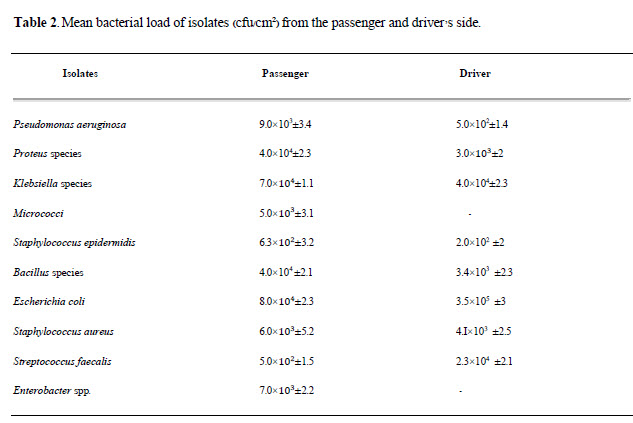Bacterial Contamination of Door Handles of Commercial Buses in Umuahia Metropolis Abia State
DOI:
https://doi.org/10.53848/ssstj.v10i1.414Keywords:
Bacterial contamination, Commercial buses door handles, AntibiogramAbstract
Commercial vehicles are all kinds of vehicles used to transport goods and people. Microbiological investigationof publicly touchable surfaces has become an interest to researchers because surfaces that are contaminated can function as reservoir of potential pathogens. This study was carried out to determine the levels of bacterialcontamination on the surfaces of two door handles on public buses within Umuahia metropolis. A total of 70samples, 35 each from the passengers and driver’s door handles surface were collected and analyzed. The analysisinvolved bacterial isolation and identification of organisms by standard microbiological procedures. Theprevalence and bacteria count were carried out. The antibiotic sensitivity pattern of the isolates were done usingthe disc diffusion method. A total number of 73 bacterial organisms were isolated. The following potentialpathogenic bacteria were observed; Staphylococcus aureus (6.8%), Staphylococcus epidermidis (5.5%),Streptococcus faecalis (2.7%), Escherichia coli (6.8%), Klebsiella spp. (5.5%), Enterobacter spp. (4.1%), Pseudomonasaeruginosa (17.8%), Proteus spp. (23.3%), Micrococcus spp. (6.8%) and Bacillus spp. (20.5%). Ofloxacin, Pefloxacinand Gentamicin are effective and exhibited encouraging results while Ampicillin and Trimethoprim were resistant to most isolates. The result actually shows that the door handles of motor vehicle used for public transportationcan be a significant reservoir for spreading potential pathogenic microorganisms.
References
Al-Ghamdi, A. K., Abdelmalek, S. M. A., Ashshi, A. M., Faidah, H., Shukri, H., & Jiman-Fatani, A. A. (2011). Bacterial contamination of computer keyboards and mice, elevator buttons and shopping carts. African Journal of Microbiology Research, 5(23), 3998-4003.
Ashgar, S. S., & El-Said, H. M. (2012). Pathogenic bacteria associated with different public environmental sites in Mecca city. Open Journal of Medical Microbiology, 2, 133-137.
Bashir, S. F., Muhammad, H., Sani, N. M., & Kawo, A. H. (2016). Isolation and identification of bacterial contaminants from door handles of public toilets in Federal University Dutse, Jigawa State-Nigeria. IOSR Journal of Pharmacy and Biological Sciences, 11(5), 53-57.
Boone, S. A., & Gerba, C. P. (2010). The prevalence of human parainfluenza virus 1 on indoor office fomites. Food and Environmental Virology, 2(1), 41-46. doi:10.1007/s12560-010-9026-5
Brooks, G. F., Carroll, K. C., Butel, J. S., & Morse, S. A. (2007). Medical microbiology (24th ed.). New York: McGraw Hill.
Cataño, J. C., Echeverri, L. M., & Szela, C. (2012). Bacterial contamination of clothes and environmental items in a third-level hospital inColombia. Interdisciplinary Perspectives onInfectious Diseases, 2012. doi:10.1155/2012/507640
Cheesbrough, M. (2006). District laboratory practicein tropical countries. New York: CambridgeUniversity Press.
Datta, P., Rani, H., Chander, J., & Gupta, V. (2009). Bacterial contamination of mobile phones of health care workers. Indian Journal of MedicalMicrobiology, 27(3), 279-281. doi:10.4103/0255-0857.53222
Fierer, N., Hamady, M., Lauber, C. L., & Knight, R. (2008). The influence of sex, handedness, andwashing on the diversity of hand surface bacteria. Proceedings of the National Academy ofSciences, 105(46), 17994-17999.
Kennedy, D. I., Enriquez, C. E., & Gerba, C. P. (2007). Enteric bacterial contamination of public restrooms. Cleaning Industry Research Institute. Retrieved from http://www. ciriscience.org
Maori, L., Agbor, V. O., & Ahmed, W. A. (2013). Theprevalence of bacterial organisms on toilet door handles in Secondary Schools in Bokkos L.G.A.,Jos, Plateau Sate, Nigeria. IOSR Journal ofPharmacy and Biological Sciences, 8(4), 85-91.
Nwankwo, E. O., & Offiah, J. C. (2016). Bacterialcontamination of user interface of automated teller machines (ATM) of various banks inUmuahia Metropolis, Abia State, Nigeria. International Journal of TropicalDisease & Health, 13(3), 1-9.
Nworie, A., Ayeni, J. A., Eze, U. A., & Azi, S. O. (2012). Bacterial contamination of door handles/knobs inselected public conveniences in Abuja metropolis, Nigeria: Apublic health threat. Continental Journalof Medical Research, 6(1), 7-11.
Onwubiko, N. E., & Chinyeaka, A. H. (2015). Isolationand identification of bacterial contaminants from door handles in a tertiary institution in Umuahia, Abia State, Nigeria. Nigerian Journal ofMicrobiology, 29, 3139-3147.
Reynolds, K. A., Watt, P. M., Boone, S. A., & Gerba, C. P. (2005). Occurrence of bacteria and biochemicalmarkers on public surfaces. International Journalof Environmental Health Research, 15(3), 225-234. doi:10.1080/09603120500115298
Sabra, S. M. M. (2013). Bacterial public health hazardin the public female restrooms at Taif, KSA. Middle-East Journal of ScientificResearch, 14(1), 63-68. doi:10.5829/idosi.mejsr.2013.14.1.7326
Ventola, C. L. (2015). The antibiotic resistance crisis: part 1: causes and threats. Pharmacy andTherapeutics, 40(4), 277-283.
Voicu, M., Cristescu, C., Zbarcea, C. E., Voicu, A.,Buda, V., Suciu, L., ... Bild, V. (2017). Comparativestudy of antimicrobials use and the antibiotic resistance of gram negative strains. Farmacia,65(2), 225-229.
Yazah, A. J., Yusuf, J., & Agbo, A. J. (2012). Bacterialcontaminants of Nigerian currency notes and associated risk factors. Research Journal ofMedical Sciences, 6(1), 1-6.
Yeh, P. J., Simon, D. M., Millar, J. A., Alexander, H. F.,& Franklin, D. (2011). A diversity of antibiotic-resistant Staphylococcus spp. in a publictransportation system. Osong Public Health andResearch Perspectives, 2(3), 202-209.doi:10.1016/j.phrp.2011.11.047
Yusha’u, M., Bello, M., & Sule, H. (2010). Isolation ofbacteria and fungi from personal and public mobile cellphones: A case study of BayeroUniversity, Kano (Old Campus). InternationalJournal of Biomedical and Health Sciences, 6, 97-102.
Zhad, P. T., Zhad, M. P., Doyle, J. R., & Meng, J. (1998). Development of a model for monitoring surfaces hygiene and environmental sanitation. International Journal of Infection Control, 6(3), 45-48.













